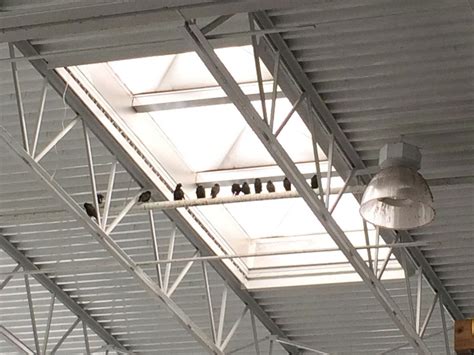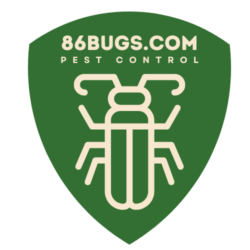-
86Bugs.com serves Metro East STL
-
sales@86bugs.com
- +1 (618) 948-0049

Are you tired of birds entering your warehouse and causing damage to your products? As an avian control specialist, 86Bugs is here to help you keep those pesky birds out and protect your inventory. In this article, I will share my expertise on how to effectively prevent birds from entering your warehouse.
Birds can cause a variety of problems in warehouses, including product contamination, property damage, and safety hazards for employees. Fortunately, there are several methods that can be used to deter them from entering the building. By implementing these strategies, you can create a bird-free environment that is safe for both your products and workers. So let’s dive into the best ways to keep birds out of your warehouse!
As an avian control specialist, it is our duty to inform warehouse owners of the risks associated with bird infestations. Bird droppings and nests can pose significant health hazards for employees and visitors. The accumulation of fecal matter can lead to respiratory issues such as histoplasmosis, a fungal infection that affects the lungs.
Apart from posing health hazards, birds can also cause damage to property by pecking at building materials or blocking gutters with their nesting materials. These damages can be costly to repair, and if left unchecked, they could lead to structural issues that would require extensive repairs.
Assessing costs related to bird infestation requires taking into account not only the immediate expenses incurred in repairing damages but also indirect costs like lost productivity due to employee illness. Seeking legal advice before implementing any measures is necessary as some species are protected under federal law.
Ultimately, preventing birds from entering your warehouse should be a priority as it helps maintain clean air quality while avoiding potential financial liabilities. In order to achieve this goal effectively, we must first identify common bird species and their behaviors.
As an avian control specialist, it’s crucial to identify the bird species you’re dealing with. Different birds have different behaviors that require specific behavior modification strategies. To start identifying common bird species, observe their physical characteristics such as size, coloration, and beak shape.
Another way of bird identification techniques is by listening to their calls or songs. Each species has a unique sound that can help narrow down your search. Additionally, observing their flight patterns can also give you clues about the type of bird you’re dealing with.
Once you’ve identified the bird species in your warehouse, it’s essential to understand their behaviors to develop effective behavior modification strategies. Some birds are territorial and will defend nesting sites aggressively, while others are scavengers looking for food sources. Understanding these behaviors will inform which tactics will work best for controlling them.
Here are some general behavior modification strategies that may work for different types of birds:
By understanding bird identification techniques and each species’ behaviors, you’ll be better equipped to modify those actions effectively. This knowledge can ensure long-term success in keeping your warehouse free from unwanted feathered guests.
Moving forward into assessing your warehouse’s vulnerability to bird infestations…
we are here to help you assess the risk of bird infestations in your warehouse. First, we’ll identify the risk factors that make your warehouse vulnerable, such as open hatches or unsecured ventilation systems. Then, we’ll look at preventive measures like netting, spikes, or visual deterrents. Finally, we’ll consider bird deterrents like sound, water, and chemical repellents. With the right combination of risk prevention and deterrents, your warehouse can be safe from bird infestations.
Are you tired of seeing birds flying around your warehouse? As an avian control specialist, we know identifying risk factors is crucial in assessing your warehouse’s vulnerability to bird infestations. Understanding bird behavior and adopting preventive measures are the keys to keeping them out.
Firstly, it is important to know what attracts birds to your warehouse. Food sources such as open containers or spillages are a major factor. Birds also seek shelter and nesting sites which could be found within the building itself or in surrounding trees. These risk factors need to be identified before implementing any prevention plan.
Secondly, understanding bird behavior is essential in preventing their entry into your warehouse. Birds tend to enter through openings such as vents or windows so sealing these areas with netting or screens will prevent access. Furthermore, installing spikes on ledges and perches where birds may roost will discourage them from landing there.
Lastly, taking preventive measures is necessary for long-term success in keeping birds out of your warehouse. Regular cleaning and maintenance of the area will eliminate food sources and nesting sites while reducing clutter and debris will remove potential hiding places for birds. Additionally, training employees on how to properly dispose of waste will further reduce attractants for birds.
In conclusion, identifying risk factors, understanding bird behavior and adopting preventive measures are key steps in assessing your warehouse’s vulnerability to bird infestations. By doing so, you’ll create an environment that is unattractive to birds thereby limiting their presence within the facility allowing staff members work more efficiently without distractions from pesky feathered creatures constantly flying about!
Now that you know the risk factors and bird behavior, it’s time to implement preventive measures to keep them out of your warehouse.
One effective way is by training employees on proper waste disposal practices as this eliminates potential food sources for birds. The less attractive your warehouse is to birds, the less likely they are to invade.
Bird proofing equipment such as netting or screens should also be installed over openings where birds can enter. This will prevent their access while still allowing air circulation within the facility. Spikes can also be placed on ledges and perches where birds may roost, further discouraging them from landing there.
Regular cleaning and maintenance of the area is crucial in eliminating any remaining attractants for birds. Ensure that debris and clutter are removed, especially near areas where food storage takes place. Cleaning up spillages immediately is important too because these could easily become a feeding ground for birds if left unchecked.
In summary, taking preventive measures such as training employees on proper waste disposal methods, installing bird proofing equipment like netting or spikes, and regular cleaning and maintenance of the area will limit the presence of birds within your warehouse. By implementing these strategies proactively, you’ll create an environment that is unattractive to birds thereby ensuring staff members work efficiently without distractions from pesky feathered creatures constantly flying about!
Now that we’ve discussed the risk factors and bird behavior associated with warehouse infestations, it’s time to delve into effective bird control measures. One of the most popular methods is using bird repellent products like sprays or gels which emit an odor or taste birds find unappealing. These products are safe for humans but work as a strong deterrent against avian pests.
Another option is visual deterrents such as reflective tape or scarecrows which simulate predators. This creates an environment where birds feel threatened, and they’ll avoid landing within your premises altogether. However, these options may not be effective in all situations and may need to be combined with other strategies.
The use of decoys can also serve as a powerful tool in controlling bird populations within warehouses. Decoys mimic natural enemies such as hawks, falcons, or owls thereby creating fear among incoming birds who will likely steer clear from their perceived predator. It’s important to note that while these measures are effective, they require regular repositioning to ensure maximum efficacy.
In conclusion, implementing preventive strategies alone isn’t enough without incorporating proper bird control measures. Using various techniques such as bird repellents, visual deterrents, and decoys can significantly reduce the likelihood of experiencing infestations within your facility. By working closely with the 86Bugs pest control specialists who are skilled in avian management services, you’ll receive expert advice on what methods best suit your specific needs ensuring a more efficient solution to any potential problem posed by pesky feathered creatures!
Physical deterrents are an effective way to keep birds out of a warehouse. Netting and spikes are two popular options for preventing birds from entering the building. These methods have been proven successful in deterring multiple bird species, including pigeons, seagulls, and crows.
Netting is typically made of high-strength material that can withstand harsh weather conditions. It creates a physical barrier that prevents birds from landing on surfaces such as roofs or loading docks. Cost effectiveness analysis shows that netting is a long-term sustainable solution for bird control as it requires minimal maintenance once installed.
Spikes also serve as a physical barrier by preventing birds from landing on ledges or other flat surfaces where they may roost or nest. They come in different sizes and materials to accommodate various areas around the warehouse. While spikes require initial installation costs, their long-term sustainability makes them cost-effective solutions for bird prevention.
When implementing physical deterrents like netting and spikes, it’s important to consider the specific needs of your warehouse. Factors such as location, size, and type of inventory stored will influence which method is best suited for your facility. By conducting a thorough assessment of these factors along with cost effectiveness analysis, you can ensure that your chosen method will provide an effective long-term solution for keeping birds out of your warehouse.
Moving forward, using visual deterrents such as scarecrows and reflective tape can also be useful in conjunction with physical barriers like netting and spikes. These methods create additional obstacles that make it difficult for birds to enter the space while avoiding harm to either party involved.
Visual deterrents are a popular and effective method of keeping birds out of warehouses. One option is to use scarecrows, which can be placed strategically around the area. These human-like figures give off an intimidating presence that will deter birds from entering the warehouse. Reflective tape is another visual deterrent that works well in deterring birds, especially during daylight hours. The tape creates flashes of light as it moves in the wind, scaring away any approaching birds.
Bird repellent sprays can also be used in conjunction with visual deterrents for added effectiveness. However, these should only be used by trained professionals who know how to apply them safely and effectively without harming birds or other wildlife.
Another way to utilize visual deterrents is through decoy birds. Placing fake predators like owls or hawks on perches within sight of the warehouse entrances sends a clear message to real-life birds that they need to stay away. Decoy birds work best at night when real predators are most active.
Incorporating various types of visual deterrence not only makes your warehouse less attractive to birds but also keeps them safe from harm. If you’re struggling with bird control in your warehouse, consider using these methods before turning to more drastic measures such as lethal force or relocation.
To further enhance bird control efforts, installing sonic deterrents such as ultrasonic devices may prove useful. These high-frequency sounds disrupt communication among flocks and create discomfort among individual birds causing them to vacate the area quickly.
Ultrasonic devices are a popular choice for bird control in warehouses. These emit high-frequency sound waves that are considered unpleasant to birds, causing them to seek out quieter areas. The advantages of using ultrasonic deterrents include their ability to cover large areas and the fact that they do not harm birds or humans.
However, it is important to note that there are also limitations to this technology. Ultrasonic devices may not be effective against all species of birds, as some have different hearing ranges than others. Additionally, these devices can be expensive and require regular maintenance to ensure proper functionality.
When choosing the right device for your warehouse, consider factors such as the size of your facility and the types of birds you are trying to deter. It may be beneficial to consult with a professional avian control specialist and the ‘box instructions / technical specs’ too.
Incorporating ultrasonic devices into your overall bird control strategy can help reduce bird activity in your warehouse. However, it should not be relied upon as the sole method of prevention. Other measures such as netting, spikes, and maintaining proper housekeeping practices should also be utilized in conjunction with sonic deterrents for optimal results.
As an avian control specialist, we have seen the devastating impact that birds can have on warehouses. Their droppings not only create unsightly messes but also pose a serious health hazard to employees and customers alike. That’s why it’s crucial for warehouse owners to prioritize proper housekeeping practices in order to minimize attractiveness to these pests.
One of the most important steps in keeping birds out of your warehouse is maintaining good sanitation. Birds are attracted to food sources like crumbs, spills, and garbage, so it’s essential to keep all areas clean and free from debris. This includes sweeping floors regularly, wiping down surfaces with disinfectant, and promptly disposing of any waste or spoiled products.
In addition to posing a health risk, bird droppings can also damage product quality by contaminating goods with bacteria and other harmful substances. To prevent this from happening, make sure all stored items are properly sealed and protected from potential contamination. Regular inspections should be conducted to ensure there are no signs of bird activity around storage areas.
By implementing these simple yet effective housekeeping measures, you can significantly reduce the likelihood of attracting unwanted feathered visitors to your warehouse. However, if you do notice signs of birds or other pests such as nests or droppings inside your facility, seeking professional assistance for bird control services may be necessary in order to fully eradicate the problem and prevent future infestations.
When it comes to bird control in a warehouse setting, many businesses may consider tackling the issue on their own. While DIY methods can be cost-effective, they often lack the same level of effectiveness as professional services. Some drawbacks of DIY bird control include inadequate knowledge and access to necessary equipment.
On the other hand, hiring a professional bird control company offers numerous benefits. Professionals have extensive experience and training in controlling avian populations in various settings, including warehouses. They also have specialized equipment that is highly effective at deterring birds from accessing your facility.
Choosing the right bird control company for your warehouse involves research into their qualifications and experience. Look for companies with certifications from reputable organizations such as the National Pest Management Association or Bird Barrier America. Additionally, read reviews from previous customers to evaluate their track record of success.
Overall, while some businesses may attempt DIY measures for bird control, seeking professional assistance can provide more comprehensive and long-lasting solutions. By choosing a qualified company with proven success in warehouse settings, you can ensure that your business remains free from unwanted avian visitors. Contact us today!
With effective bird control measures in place, evaluating their ongoing effectiveness becomes important to maintain protection against future infestations.
As bird control specialists, we often compare our efforts to keep birds out of warehouses to tending a garden. Just as you wouldn’t plant seeds and forget about them, we can’t simply install bird control measures and assume they’ll work indefinitely. Like a gardener who regularly checks on their plants’ growth and adjusts their care accordingly, we must continually evaluate the effectiveness of our bird control strategies.
Measuring effectiveness is key in determining whether or not your current bird control methods are working. This involves monitoring both the success rate of the implemented measures and the level of bird activity within the warehouse. If there has been no noticeable decrease in bird presence or damage caused by birds despite implementing controls, it’s important to reevaluate your approach.
In addition to measuring effectiveness, improving strategies is crucial for successful avian control. Based on your evaluation results, consider modifying existing measures or implementing new ones altogether. For example, if spikes have proven ineffective at deterring perching birds from certain areas, netting may be more effective in those specific locations.
To aid in evaluating effectiveness and identifying areas for improvement, use this table:
| Bird Control Measure | Success Rate (%) | Level of Bird Activity |
|---|---|---|
| Netting | 90 | Low |
| Spikes | 60 | Medium |
| Sound deterrents | 30 | High |
| Visual deterrents | 50 | Low-Medium |
Remember that even with effective measures in place, regular maintenance and upkeep are necessary to ensure continued success. By taking an active role in evaluating and improving upon your bird control strategies, you can effectively keep these pests out of your warehouse without causing harm to either humans or birds alike.
Keep up-to-date with the latest research findings and techniques used throughout the industry while exploring alternative approaches through collaboration with others involved in similar roles will help reduce the prevalence of bird entry.

Birds can indeed cause damage to products stored in a warehouse, as they have a tendency to peck at and scratch surfaces. Additionally, their droppings can pose a serious hygiene risk for any items or equipment stored within the facility. As an avian control specialist, I highly recommend implementing bird repellent methods such as netting, spikes, or ultrasonic devices to deter birds from entering the warehouse. These measures not only protect your merchandise but also ensure that employees are working in a safe and clean environment free of any potential health hazards caused by bird presence.
As an avian control specialist, it’s important to understand the legal regulations for bird control methods in warehouses. While there are no specific laws regarding this issue, companies must comply with environmental impact regulations when implementing such measures. As a result, it’s essential to use humane and environmentally friendly tactics that don’t harm birds or other wildlife. Effective solutions include installing bird netting, using bird spikes or deterrents, and addressing any food sources or nesting areas near the warehouse. By prioritizing ethical and sustainable practices, businesses can keep their products safe while minimizing harm to the surrounding ecosystem.
As an avian control specialist, it is crucial to address the impact that bird droppings can have on warehouse employees. Bird droppings can pose a significant health risk due to their potential to carry diseases and respiratory irritants. Furthermore, they can create slippery surfaces which could result in slips and falls for workers. It’s essential for warehouses to prioritize professional bird control services in order to prevent these issues from occurring. By implementing preventative measures such as netting or spikes, we can ensure the safety and wellbeing of everyone within the workplace environment.
As an expert in avian control, it’s crucial to understand that bird control measures indeed need to be adjusted seasonally. Best practices dictate that different weather conditions call for varying strategies and techniques. For example, during the summer months, birds are more likely to seek shelter from the heat by nesting on ledges or inside buildings. Therefore, it may be necessary to install netting or spikes around potential roosting sites. On the other hand, during winter months, food sources become scarce, leading birds to scavenge for scraps near warehouses and factories. In such cases, installing repellents like sonic devices can help deter them from entering these areas. By adapting our approach based on weather considerations, we can ensure maximum effectiveness in keeping unwanted feathered guests at bay.
As an avian control specialist, it’s important to stress the significance of regular bird control maintenance in warehouses. Cost effective methods such as netting, spikes, and deterrents should be inspected seasonally to ensure their effectiveness. Outsourcing options are also available for those who may not have the resources or expertise to maintain these measures on their own. Neglecting routine inspections can lead to costly damages caused by birds, along with health hazards posed by their droppings. It’s essential that warehouse owners prioritize bird control maintenance as a preventative measure rather than waiting until a problem arises.
In conclusion, as a bird control specialist, 86Bugs highly recommends implementing effective measures to keep birds out of your warehouse. Not only can they cause damage to products and equipment but their droppings can also pose health risks to employees. It is important to note that there are legal regulations for bird control in warehouses so it’s best to consult with professionals.
One interesting statistic worth noting is that according to the National Pest Management Association, bird infestations cost businesses an estimated $1 billion annually.
One interesting statistic worth noting is that according to the National Pest Management Association, bird infestations cost businesses an estimated $1 billion annually.
This emphasizes the importance of taking proactive steps towards avian control in order to prevent any potential damages or costs down the line. Remember, by regularly maintaining proper bird control measures, you can ensure the safety and success of your business operations.



